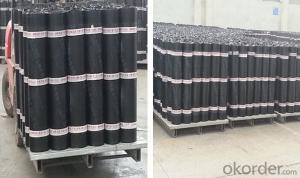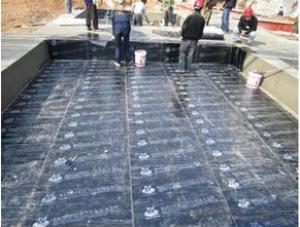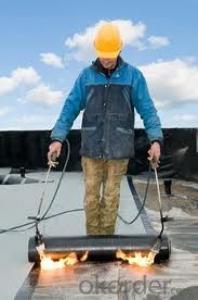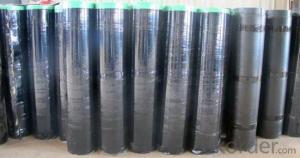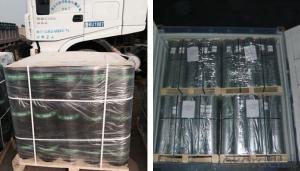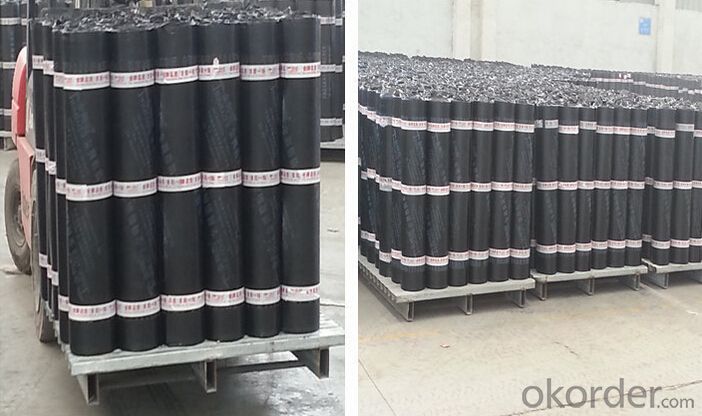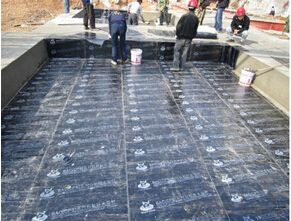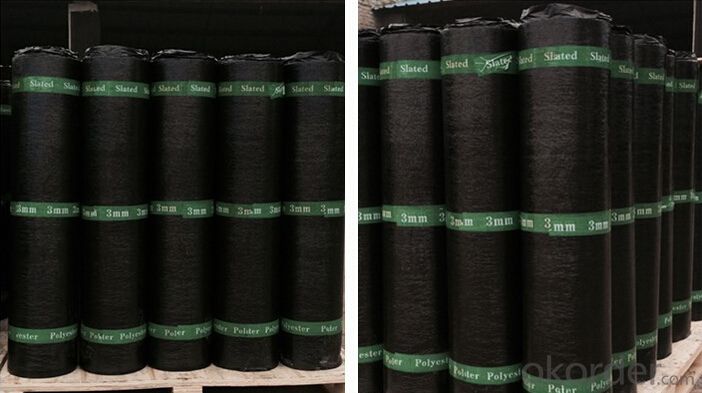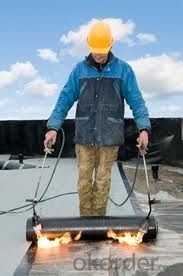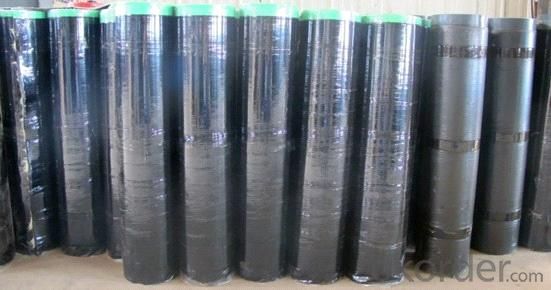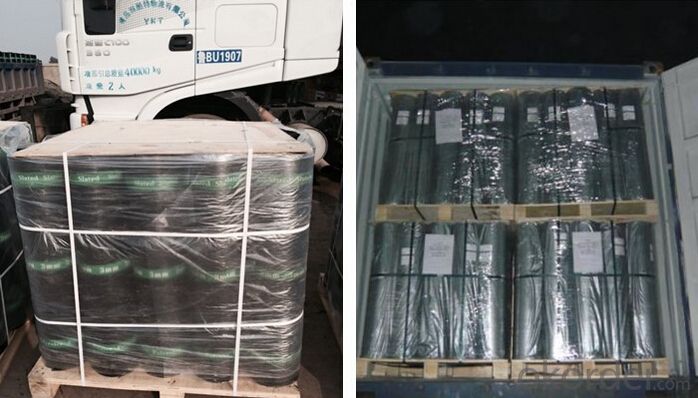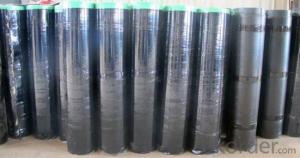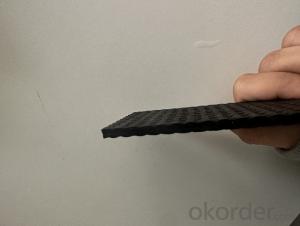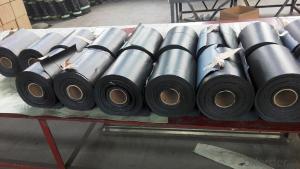Sbs Elastomeric Bitumen Membrane Waterproof Membrane For Bathroom Floors For Bathroom Floors
- Loading Port:
- Shanghai
- Payment Terms:
- TT OR LC
- Min Order Qty:
- 1000 m²
- Supply Capability:
- 200000 m²/month
OKorder Service Pledge
OKorder Financial Service
You Might Also Like
product description:
sbs waterproof membrane take the “Skin” type waterproof thought, according to the features of construction site, on the basis of width elastomeric modified bitumen waterproofing membrane, combining with features of wet-application self-adhesive membrane, use advanced equipment to produce 2 meters width that WP-SBS wet-application width elastomeric modified bitumen waterproofing membrane (Hereinafter referred to: WP-SBS membrane).WP-SBS is made of bitumen modified with Styrene-Butadiene- Styrene (SBS)as dipping and painting. Its upper surface covers PE membrane and color sand or schist, and lower surface is made of isolation material. Products correspond to the national standards GB18242-2008(elastomeric modified bitumen waterproofing membrane), paste by cement or cement mortar, and construct on the wet base, achieving tight and full adhesion with substrates, eliminating fluid-channeling layer, all above contribute to making a reliable “Skin” type waterproof system, which is a breakthrough innovation in ordinary modified bitumen membrane.
Characteristic
1.Good impermeability
2.Possess good tensile strength, elongation and size stability which could be well suited the substrate distortion and crack.
3.Good performance in anti-strength, anti-resistance , anti-erosion, anti-mildew, anti-weathering
4.SBS modified bitumen membrane is specially being applied in the cold area with low temperature, while APP modified bitumen membrane is applied in the area with high temperature.
5.Convenient installation
Applicable scope:
It is widely used for civil building roofing, underground, bridge, parking, pool, tunnel in the line of waterproofing and dampproofing, especially for the building under high temperature.
Application
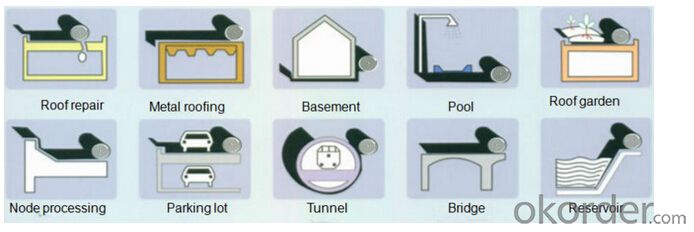
Our Services
1.If you need some advises for the waterproof construction, we have the best engineer to serve you.
2.We send the free samples to you by freight collect.
3.We will guarantee the quality and the competitive price.
4.We will give you the best packaging and safe shipping.
5.If any problem, we will always be right here waiting for you.
Packaging & Shipping
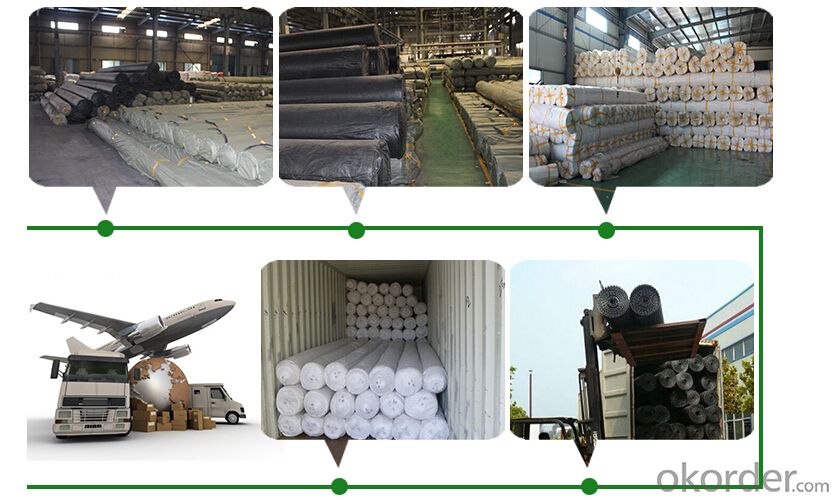
| Packing | Woven bag/PE bag packing or as customer request |
| Shipping | FOB Changsha,customized shipping terms and oppointed port accepted |
Technical parameter
| Item | Specifications | ||||||||
| Geotextile Unit Weight (g/m²) | 300 | 500 | 600 | 700 | 800 | 900 | 1000 | 1100 | |
| Geomembrane Thickness (mm) | 0.25-0.35 | 0.30-0.50 | |||||||
| Nominal Fracture Strength (KN/m) | 2.50 | 7.50 | 10 | 12 | 14 | 16 | 18 | 20 | |
| Breaking Strength (KN/m,≥,LD/TD) | 2.50 | 7.50 | 10 | 12 | 14 | 16 | 18 | 20 | |
| Standard Intensity Corresponding Elongation Rate (%) | 30~100 | ||||||||
| CBR Burst Strength (KN,≥) | 0.70 | 1.50 | 1.90 | 2.20 | 2.50 | 2.80 | 3.00 | 3.20 | |
| Longitudinal Tear Strength (KN,≥) | 0.05 | 0.25 | 0.32 | 0.40 | 0.48 | 0.56 | 0.62 | 0.70 | |
| Hydrostatic Pressve (Mpa) | See List Below | ||||||||
| Peel Strength (N/cm,≥) | 6 | ||||||||
| Vertical Permeability Coefficient (cm/s) | According to design or contract mentioned. | ||||||||
| Width Variation (%) | -1.00 | ||||||||
| Item | Geomembrane Thickness (mm) | ||||||||
| 0.20 | 0.30 | 0.40 | 0.50 | 0.60 | 0.70 | 0.80 | 1.00 | ||
| Hydrostatic Pressve (Mpa) | One geotextiles with one geomembrane | 0.40 | 0.50 | 0.60 | 0.80 | 1.00 | 1.20 | 1.40 | 1.60 |
| Two geotextiles with one geomembrane | 0.50 | 0.60 | 0.80 | 1.00 | 1.20 | 1.40 | 1.60 | 1.80 | |
Professional test machines ensure the products qualified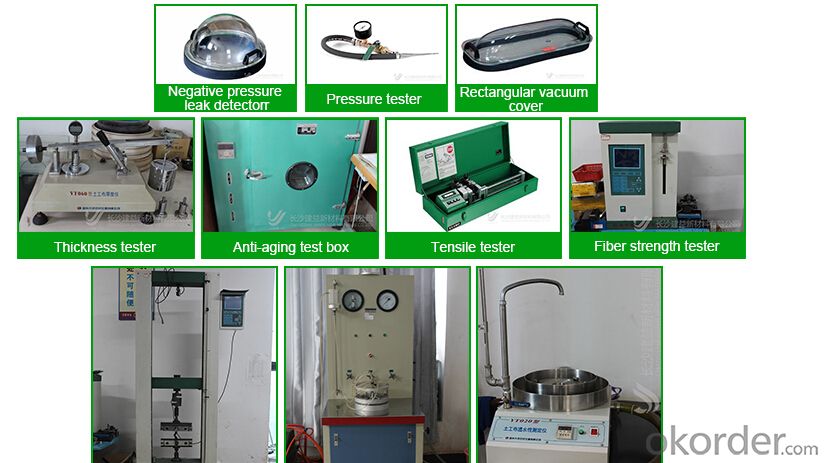 roduct certifications
roduct certifications
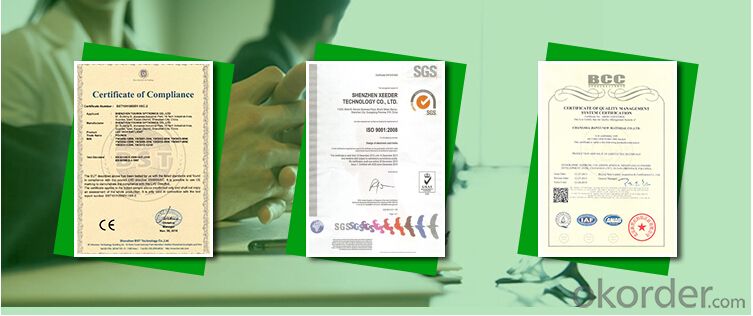
Inquiry Note
How to send an effective inquiry for saving your time?
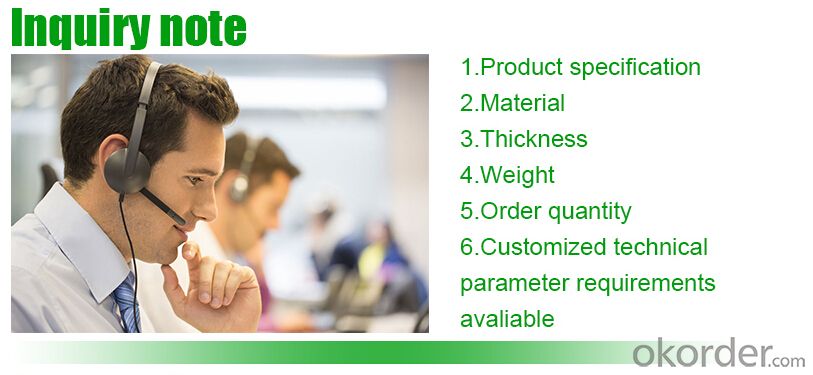
product show
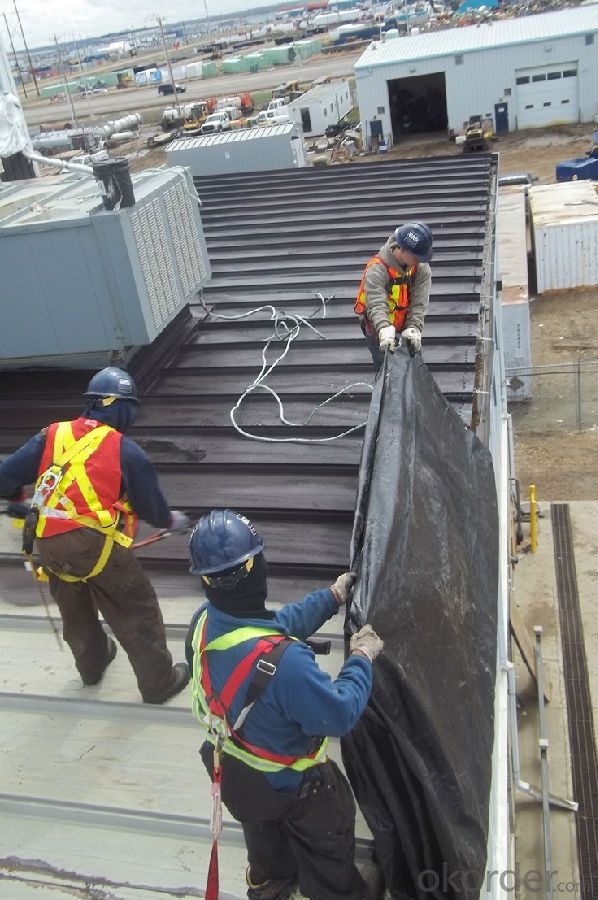
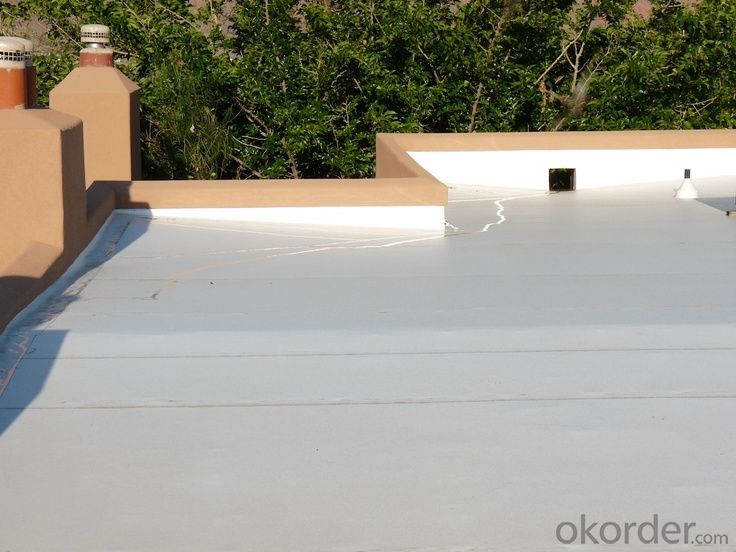

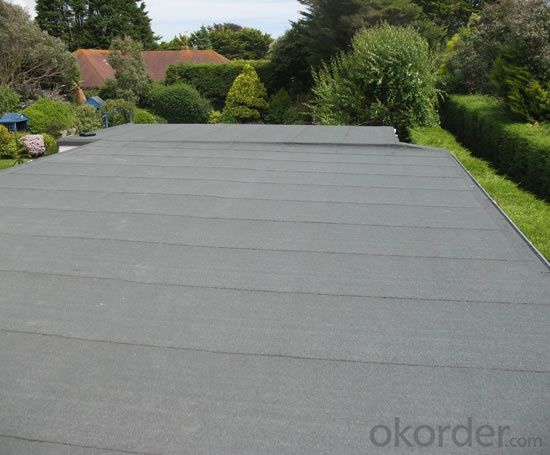
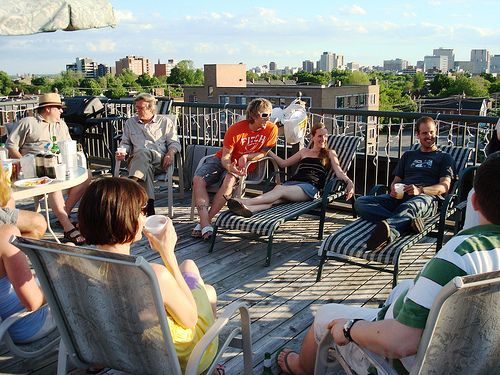
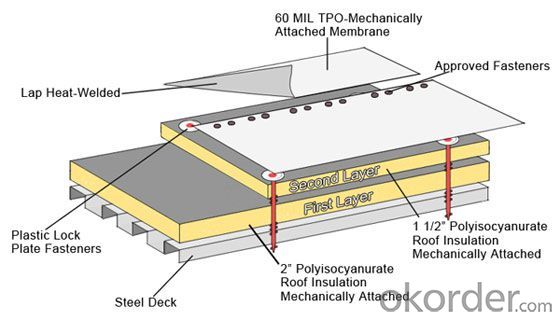
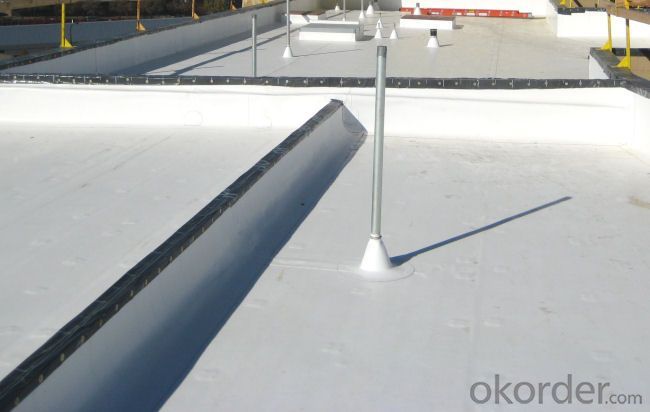
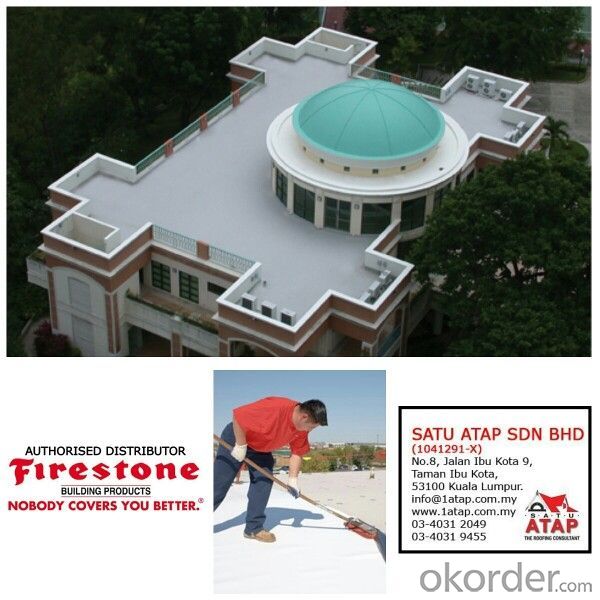
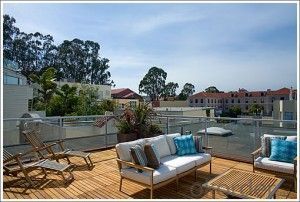
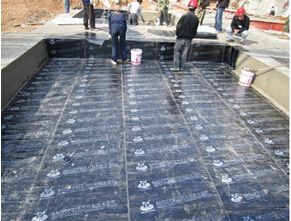
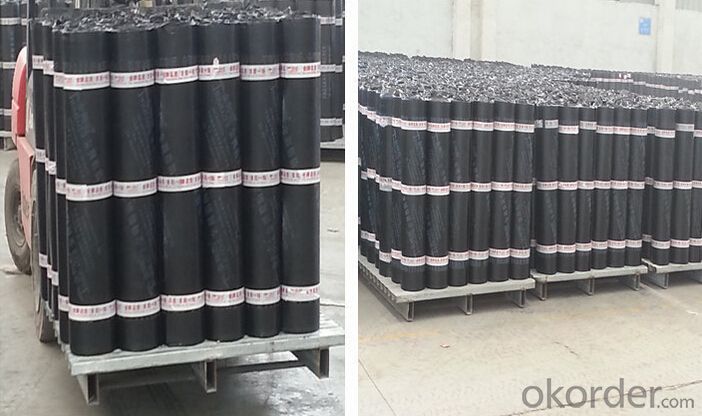
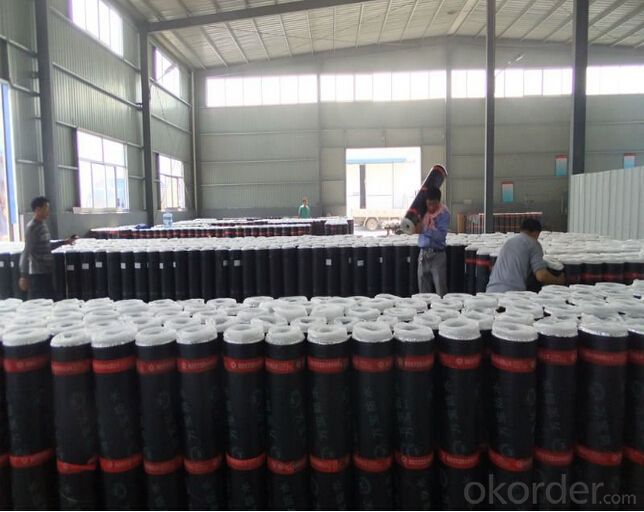
FAQ

- Q: Can a waterproofing membrane be used for underground utility vaults?
- Indeed, underground utility vaults can benefit from the utilization of waterproofing membranes. These specialized membranes are specifically engineered to serve as a shield against water infiltration, and they find extensive application in a wide range of construction projects, such as underground structures like utility vaults. By employing waterproofing membranes, the undesirable consequences of water damage, corrosion, and leakage can be effectively averted in underground vaults, thereby safeguarding the utilities and equipment housed within and ensuring their durability and longevity.
- Q: Can waterproofing membranes be used on mechanical equipment rooms?
- Waterproofing membranes are suitable for application in mechanical equipment rooms. These membranes have been specifically designed to create a protective barrier, safeguarding against water penetration and preventing any potential harm caused by moisture to the underlying structures. The installation of these membranes within mechanical equipment rooms, which often house valuable and sensitive machinery, proves advantageous as it ensures the durability and functionality of the equipment. By applying waterproofing membranes to the walls, floors, and ceilings of these rooms, it effectively prevents water leaks, moisture accumulation, and any potential harm resulting from water infiltration. This is particularly crucial in regions that experience heavy rainfall, high humidity, or possess a high water table. Additionally, the use of waterproofing membranes aids in regulating condensation and discouraging the growth of mold, both of which could adversely impact the performance of mechanical equipment. In summary, the utilization of waterproofing membranes in mechanical equipment rooms offers a practical and efficient solution for equipment protection and the maintenance of optimal performance.
- Q: The difference between high polymer modified asphalt waterproofing membrane and sbs
- SBS modified asphalt waterproofing membrane is SBS rubber modified petroleum asphalt cited as the invasion coating, polyester fiber non-woven fabrics, jute cloth, fiberglass mats were made for the fetal base, the plastic film for the anti-sticking isolation Layer, by the selection, ingredients, eutectic, invasion, composite molding, curling and other processes processing production.
- Q: Are waterproofing membranes resistant to oil and grease?
- Yes, waterproofing membranes are often resistant to oil and grease. These membranes are designed to create a barrier against water infiltration, and many of them are also made to withstand exposure to various chemicals, including oil and grease. This resistance is typically achieved through the use of specialized materials and coatings that are able to repel or prevent absorption of oil and grease. However, it is important to note that the level of resistance can vary depending on the specific type and brand of the waterproofing membrane. Therefore, it is advisable to consult the manufacturer's specifications or seek professional advice to ensure the membrane chosen is suitable for the specific application and level of oil and grease exposure.
- Q: Can a waterproofing membrane be used in commercial buildings?
- Indeed, it is possible to utilize a waterproofing membrane in commercial establishments. Waterproofing membranes serve the purpose of safeguarding diverse sections of a building, encompassing roofs, foundations, and basements, against water infiltration. In the case of commercial buildings, where the likelihood of water harm is heightened due to larger surface areas, increased foot traffic, and intricate architectural designs, waterproofing membranes prove to be a viable solution. These membranes are specially crafted to establish a protective barrier against water, thereby averting leaks, moisture, and potential structural harm. Furthermore, the integration of waterproofing membranes contributes to the longevity of the building by reducing the risk of deterioration resulting from exposure to water. Consequently, the incorporation of a waterproofing membrane system in commercial establishments aids in maintaining a secure and dry environment, safeguarding valuable assets, and optimizing the lifespan of the structure.
- Q: Can a waterproofing membrane be used in new construction?
- Yes, a waterproofing membrane can be used in new construction. In fact, it is often recommended to install a waterproofing membrane during the construction phase to provide an added layer of protection against water damage. Waterproofing membranes are typically applied to the exterior foundation walls and basement floors to prevent water infiltration and to create a barrier against moisture. This can help to prevent issues such as leaks, mold, and structural damage in the future. Additionally, waterproofing membranes can also be used in other areas of a new construction project, such as roofs, balconies, and bathrooms, to ensure long-lasting waterproofing protection. Overall, using a waterproofing membrane in new construction can help to prolong the lifespan of the building and provide peace of mind for the occupants.
- Q: Can a waterproofing membrane be used for a retaining wall drainage?
- Using a waterproofing membrane is an effective method for retaining wall drainage. Typically used to prevent water from penetrating structures like basements or foundations, this membrane can also serve as a barrier against water seepage in retaining wall construction. Retaining walls are designed to hold back soil and prevent erosion, but without proper construction, they can be vulnerable to water damage. If water seeps through, it can create pressure behind the wall, causing structural problems over time. By installing a waterproofing membrane on the backside of the retaining wall, water infiltration into the soil and accumulation behind the wall can be prevented. Furthermore, a waterproofing membrane can help with the drainage of water away from the retaining wall. By incorporating drainage systems like weep holes or French drains, alongside the membrane, water can be directed away from the wall, reducing hydrostatic pressure and potential damage. It's important to note that while a waterproofing membrane can be used for retaining wall drainage, proper installation and compatibility with the specific retaining wall system and conditions are crucial. It's recommended to consult with a professional engineer or contractor experienced in retaining wall construction to ensure the most suitable approach for your specific project.
- Q: Does a waterproofing membrane require any curing time?
- Indeed, a curing time is typically necessary for a waterproofing membrane to fully bond and establish a robust, impermeable barrier. The duration of this curing period can differ based on the type of membrane employed and the instructions provided by the manufacturer. While the membrane is undergoing the curing process, precautions should be taken to shield it from foot traffic, water exposure, and any other potential sources of harm. Adhering to the recommended curing time is crucial in guaranteeing the membrane's effectiveness and durability.
- Q: How does a waterproofing membrane handle exposure to UV rays?
- A waterproofing membrane is designed to handle exposure to UV rays by incorporating UV stabilizers and additives into its composition. These UV stabilizers work by absorbing or reflecting the harmful UV rays, preventing them from causing degradation or damage to the membrane. UV rays from the sun can be quite intense and can lead to the deterioration of various materials over time. When a waterproofing membrane is continuously exposed to UV rays, it can undergo a process called photo-oxidation, where the energy from the UV rays reacts with the membrane's molecular structure, causing it to break down and weaken. To counteract this, manufacturers add UV stabilizers to the membrane during the manufacturing process. These stabilizers act as a shield, absorbing or reflecting the UV rays and preventing them from reaching the membrane's surface. By doing so, they help to slow down the process of photo-oxidation and extend the lifespan of the waterproofing membrane. Additionally, some waterproofing membranes may also have a protective layer or coating that provides additional UV resistance. This layer acts as an extra barrier, shielding the membrane from direct exposure to UV rays and further enhancing its durability and longevity. However, it's important to note that even with UV stabilizers and protective coatings, prolonged exposure to intense UV rays can still cause some degree of degradation or discoloration over time. Therefore, it is recommended to regularly inspect and maintain the waterproofing membrane to ensure its effectiveness and address any signs of UV damage promptly.
- Q: Can a waterproofing membrane be used for water tanks?
- Yes, a waterproofing membrane can be used for water tanks. Waterproofing membranes are specifically designed to prevent the passage of water and can effectively seal water tanks, ensuring that they remain watertight. These membranes are commonly made from materials such as bitumen, PVC, or EPDM, which provide excellent resistance to water and are capable of withstanding the harsh conditions often found in water tanks. Additionally, waterproofing membranes can be applied to various surfaces, including concrete, metal, and masonry, making them versatile and suitable for different types of water tanks. Overall, using a waterproofing membrane is a reliable solution for ensuring the integrity and longevity of water tanks by preventing water leakage and protecting the surrounding environment from potential water damage.
Send your message to us
Sbs Elastomeric Bitumen Membrane Waterproof Membrane For Bathroom Floors For Bathroom Floors
- Loading Port:
- Shanghai
- Payment Terms:
- TT OR LC
- Min Order Qty:
- 1000 m²
- Supply Capability:
- 200000 m²/month
OKorder Service Pledge
OKorder Financial Service
Similar products
Hot products
Hot Searches
Related keywords
